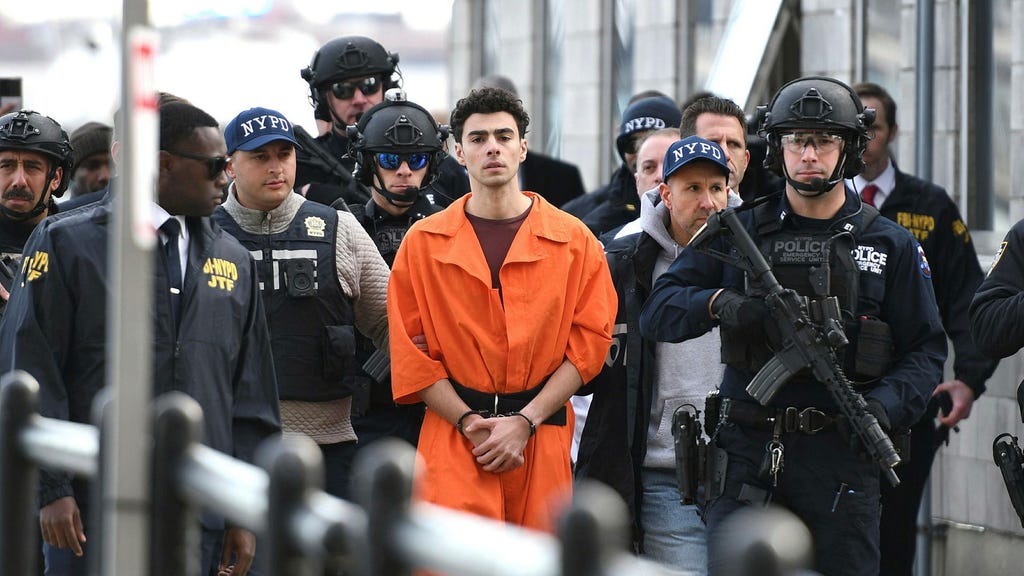The return to city life after the holidays was overshadowed by an ongoing obsession: the case of Luigi Mangione, the 26-year-old accused of assassinating Brian Thompson, CEO of United Healthcare. This wasn’t a private fascination; the internet was ablaze with Mangione’s image. From the moment surveillance photos were released, his hooded figure, sharp jawline, and piercing gaze captivated social media. The subsequent arrest at an Altoona McDonald’s only amplified the frenzy. Images of a shirtless Mangione, elite university photos, and glimpses into his affluent Baltimore family life flooded the web. He became an instant icon, his face plastered on merchandise, his mugshot tattooed on bodies, and his story romanticized in songs and fan fiction.
This fascination intensified over the holiday period, fueled by dramatic footage of Mangione’s extradition to New York. Arriving by helicopter, clad in an orange jumpsuit amidst a sea of dark-suited officers, he exuded an aura of calm, almost arrogant, composure. This visual narrative of a defiant hero resonated deeply, garnering support not only from women but also from men, expressed through online emojis and the ubiquitous hashtag #freeluigi. The narrative transcended simple attraction, morphing into a symbolic representation of resistance against powerful institutions.
This phenomenon, the rapid and widespread idealization of an accused murderer, begs explanation. Firstly, it highlights the potent “halo effect,” the psychological tendency to associate physical attractiveness with innocence. As Vanessa Friedman noted in the New York Times, Mangione’s case exemplifies this, illustrating how societal biases can cloud judgment. Studies have demonstrated that attractive defendants often receive lighter sentences, reinforcing the real-world implications of this cognitive bias. The public’s perception of Mangione’s guilt or innocence seemed to be swayed by his appearance, eclipsing the tragic reality of a life lost and a grieving family.
Secondly, the victim’s identity as a healthcare industry leader played a significant role. Brian Thompson represented a system perceived by many as profiting from human suffering. Mangione, in this narrative, became an avenging figure, channeling public anger against the healthcare industry. Social media pronouncements like “Mangione killed one, the companies millions” encapsulate this sentiment, portraying him as a vigilante fighting against corporate greed. This framing of the narrative further solidified Mangione’s heroic image, turning him into a symbol of rebellion against a flawed system.
Furthermore, Mangione’s strategic silence amplified his mystique. In a world saturated with information and self-promotion, his refusal to speak publicly became a powerful tool. This silence provided a blank canvas onto which admirers could project their own desires, fantasies, and grievances. He became a mirror reflecting the anxieties and hopes of a diverse group, each interpreting his silence according to their own narrative. He was simultaneously a heartthrob, a relatable friend, a protective brother, and a symbol of societal discontent. His silence became a language understood and embraced by many, each finding resonance with their own personal narrative.
Personally, as a 63-year-old culture enthusiast, I found myself projecting intellectual and sensitive qualities onto Mangione. I envisioned him engaged in deep conversations with his lawyer, immersed in the pages of Don DeLillo’s “Libra.” This illustrates the power of the unknown and the human tendency to fill the void with our own imaginings. This silence, however, is a fragile shield. The upcoming trial, scheduled for February 21st, promises to shatter the carefully constructed image. As Mangione’s voice breaks the silence, the carefully curated persona risks crumbling, revealing the man behind the myth. The question remains: who will Luigi Mangione truly be when he chooses to speak? Will the reality align with the projected image, or will the silence prove to be a more compelling narrative than the truth?














